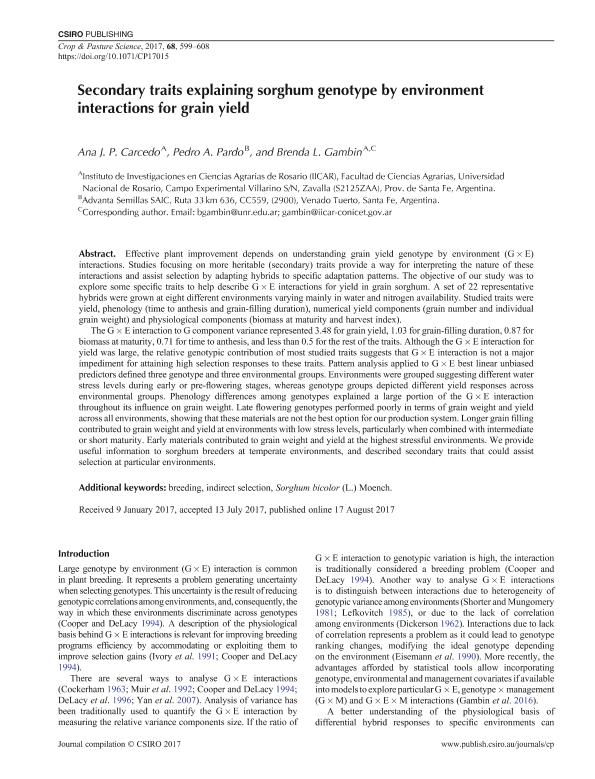Mostrar el registro sencillo del ítem
dc.contributor.author
Carcedo, Ana Julia Paula

dc.contributor.author
Pardo, Pedro A.
dc.contributor.author
Gambin, Brenda Laura

dc.date.available
2023-01-27T10:45:44Z
dc.date.issued
2017-08
dc.identifier.citation
Carcedo, Ana Julia Paula; Pardo, Pedro A.; Gambin, Brenda Laura; Secondary traits explaining sorghum genotype by environment interactions for grain yield; Csiro Publishing; Crop and Pasture Science; 68; 7; 8-2017; 599-608
dc.identifier.issn
1836-0947
dc.identifier.uri
http://hdl.handle.net/11336/185856
dc.description.abstract
Effective plant improvement depends on understanding grain yield genotype by environment (G×E) interactions. Studies focusing on more heritable (secondary) traits provide a way for interpreting the nature of these interactions and assist selection by adapting hybrids to specific adaptation patterns. The objective of our study was to explore some specific traits to help describe G×E interactions for yield in grain sorghum. A set of 22 representative hybrids were grown at eight different environments varying mainly in water and nitrogen availability. Studied traits were yield, phenology (time to anthesis and grain-filling duration), numerical yield components (grain number and individual grain weight) and physiological components (biomass at maturity and harvest index). The G×E interaction to G component variance represented 3.48 for grain yield, 1.03 for grain-filling duration, 0.87 for biomass at maturity, 0.71 for time to anthesis, and less than 0.5 for the rest of the traits. Although the G×E interaction for yield was large, the relative genotypic contribution of most studied traits suggests that G×E interaction is not a major impediment for attaining high selection responses to these traits. Pattern analysis applied to G×E best linear unbiased predictors defined three genotype and three environmental groups. Environments were grouped suggesting different water stress levels during early or pre-flowering stages, whereas genotype groups depicted different yield responses across environmental groups. Phenology differences among genotypes explained a large portion of the G×E interaction throughout its influence on grain weight. Late flowering genotypes performed poorly in terms of grain weight and yield across all environments, showing that these materials are not the best option for our production system. Longer grain filling contributed to grain weight and yield at environments with low stress levels, particularly when combined with intermediate or short maturity. Early materials contributed to grain weight and yield at the highest stressful environments. We provide useful information to sorghum breeders at temperate environments, and described secondary traits that could assist selection at particular environments.
dc.format
application/pdf
dc.language.iso
eng
dc.publisher
Csiro Publishing

dc.rights
info:eu-repo/semantics/openAccess
dc.rights.uri
https://creativecommons.org/licenses/by-nc-sa/2.5/ar/
dc.subject
BREEDING
dc.subject
INDIRECT SELECTION
dc.subject
SORGHUM BICOLOR (L.) MOENCH.
dc.subject.classification
Agricultura

dc.subject.classification
Agricultura, Silvicultura y Pesca

dc.subject.classification
CIENCIAS AGRÍCOLAS

dc.title
Secondary traits explaining sorghum genotype by environment interactions for grain yield
dc.type
info:eu-repo/semantics/article
dc.type
info:ar-repo/semantics/artículo
dc.type
info:eu-repo/semantics/publishedVersion
dc.date.updated
2023-01-26T17:30:40Z
dc.identifier.eissn
1836-5795
dc.journal.volume
68
dc.journal.number
7
dc.journal.pagination
599-608
dc.journal.pais
Australia

dc.description.fil
Fil: Carcedo, Ana Julia Paula. Consejo Nacional de Investigaciones Científicas y Técnicas. Centro Científico Tecnológico Conicet - Rosario. Instituto de Investigaciones en Ciencias Agrarias de Rosario. Universidad Nacional de Rosario. Facultad de Ciencias Agrarias. Instituto de Investigaciones en Ciencias Agrarias de Rosario; Argentina
dc.description.fil
Fil: Pardo, Pedro A.. Advanta Semillas S.A.I.C.; Argentina
dc.description.fil
Fil: Gambin, Brenda Laura. Consejo Nacional de Investigaciones Científicas y Técnicas. Centro Científico Tecnológico Conicet - Rosario. Instituto de Investigaciones en Ciencias Agrarias de Rosario. Universidad Nacional de Rosario. Facultad de Ciencias Agrarias. Instituto de Investigaciones en Ciencias Agrarias de Rosario; Argentina
dc.journal.title
Crop and Pasture Science
dc.relation.alternativeid
info:eu-repo/semantics/altIdentifier/doi/http://dx.doi.org/10.1071/CP17015
Archivos asociados
